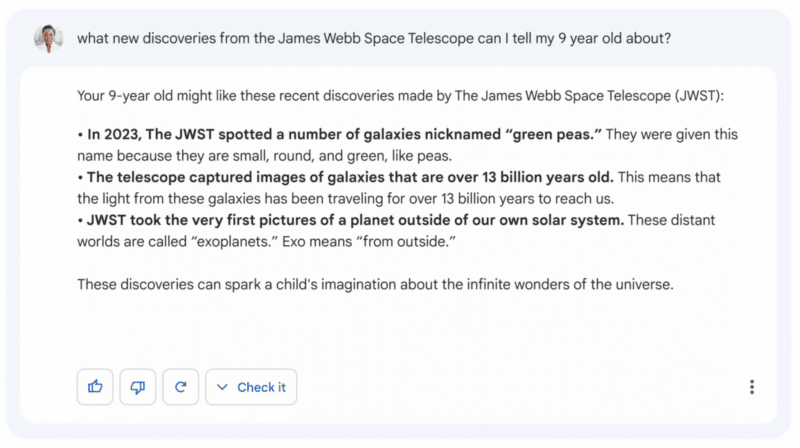Google is now testing its answer to OpenAI’s ChatGPT with what the search company is called Bard.
Google CEO Sundar Pichai on the company’s blog about the soft launch of Bard to a set “trusted testers,” showcasing what this early experimental release looks like with some examples.
We knew this was coming, as Pichai mentioned this on the Google earnings call.
What Bard looks like
Let’s first start with what it looks like in Google Search, that is what everyone has been asking, so let’s jump to some screenshots. Here is a screenshot Google shared that shows how Googe Search uses Bard to respond to long queries with a long AI-created response.
This screenshot below is how Google may integrate Bard directly into Google Search:

Sundar Pichai wrote:
“Soon, you’ll see AI-powered features in Search that distill complex information and multiple perspectives into easy-to-digest formats, so you can quickly understand the big picture and learn more from the web: whether that’s seeking out additional perspectives, like blogs from people who play both piano and guitar, or going deeper on a related topic, like steps to get started as a beginner.” Google said, “these features will rolling out on Google Search soon.”
Here is another screenshot from Google on how Bard might respond to questions:

In this case, Bard is explaining new discoveries from NASA’s James Webb Space Telescope to a 9-year-old. This screenshot is more of a specialized user interface for users to interact with Bard outside of Google Search.
As you can see, there is no one right answer for this question.
What is Google Bard?
Google explains that Bard is an experimental conversational AI service, powered by LaMDA (Language Model for Dialogue Applications). LaMDA was announced two years ago, at the 2021 Google I/O keynote, as Google’s next-generation language and conversation capabilities. It is now being used to create these answers for searchers.
Bard is powered by a lightweight model version of LaMDA, which requires “significantly less computing power,” Google said. Google said this will allow them to scale to more users while also allowing for more feedback.
“Bard seeks to combine the breadth of the world’s knowledge with the power, intelligence, and creativity of our large language models. It draws on information from the web to provide fresh, high-quality responses. Bard can be an outlet for creativity, and a launchpad for curiosity, helping you to explain new discoveries from NASA’s James Webb Space Telescope to a 9-year-old, or learn more about the best strikers in football right now, and then get drills to build your skills,” Sundar Pichai said.
Bard is experimental
Google used the words experiment and testing and other variations of that many times in the blog post. Google said they are excited for this “phase of testing to help us continue to learn and improve Bard’s quality and speed.”
Who are trusted testers?
Google told us they are not the Search Quality Raters, instead they are a demographically and geographically diverse group of people external to Google. These testers test Google’s products to help Google improve and understand how real users are likely to experience these products. Google said they work with a third-party supplier to provide this testing. It is unclear how you or I can test out Bard before it launches more widely.
Attribution and citations
I asked Google how it plans to provide attribution and/or citations for the answers Bard provides to searchers. Google did not have an immediate comment at the time this was published. If/when we hear back, we will update this story and maybe write a new story.
Why we care
It is fascinating to see how search and AI companies are adding human-like question-and-answer responses to search. Google Search seems to be taking a similar approach to ChatGPT thus far, but it is early and I do expect the user experience and interfaces to change rapidly over time.
How Google may handle attribution and citation is an interesting topic as well. Google has used AI to write knowledge panels for years, which is why Google does not always show attribution for some knowledge panels.
Earlier reports
Earlier this week, we reported Google is rumored to have started on its own version named Apprentice Bard. CNBC reported,
When a question is entered, the search results show a gray bubble directly under the search bar, offering more human-like responses than typical search results. Directly beneath that, the page suggests several follow-up questions related to the first one. Under that, it shows typical search results, including links and headlines.
Google responded:
“We have long been focused on developing and deploying AI to improve people’s lives. We believe that AI is foundational and transformative technology that is incredibly useful for individuals, businesses and communities, and as our AI Principles outline, we need to consider the broader societal impacts these innovations can have. We continue to test our AI technology internally to make sure it’s helpful and safe, and we look forward to sharing more experiences externally soon.”
What about Microsoft and ChatGPT?
Meanwhile, Microsoft invested heavily in OpenAI, the creators of ChatGPT. Microsoft is rumored to be bringing GPT-4 to Bing search in some way in the very near future. Many companies, especially those in search, are taking these technologies very seriously after the explosion OpenAI made with the debut of ChatGPT.
We recently saw leaked screenshots of Bing’s interface for ChatGPT integration.
The post Google launches Bard, its answer to ChatGPT – here’s what it looks like appeared first on Search Engine Land.
No comments:
Post a Comment